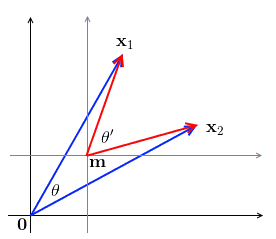Cosine Similarity
Cosine similarity is a Similarity Function that is often used in Information Retrieval
- it measures the angle between two vectors, and in case of IR - the angle between two documents
Derivation
-
recall the definition of the Dot Product: $\mathbf v \cdot \mathbf w = | \mathbf v | \cdot | \mathbf w | \cdot \cos \theta$ - or, by rearranging get $\cos \theta = \cfrac{\mathbf v \cdot \mathbf w}{| \mathbf v | \cdot | \mathbf w - so, let’s define the cosine similarity function as $\text{cosine}(\mathbf d_1, \mathbf d_2) = \cfrac{\mathbf d_1^T \mathbf d_2}{| \mathbf d_1 | \cdot | \mathbf d_2 - cosine is usually $[-1, 1]$, but document vectors (see Vector Space Model) are usually non-negative, so the angle between two documents can never be greater than 90 degrees, and for document vectors $\text{cosine}(\mathbf d_1, \mathbf d_2) \in [0, 1]$ - min cosine is 0 (max angle: the documents are orthogonal) - max cosine is 1 (min angle: the documents are the same)
Cosine Normalization
If documents have unit length, then cosine similarity is the same as Dot Product
-
$\text{cosine}(\mathbf d_1, \mathbf d_2) = \cfrac{\mathbf d_1^T \mathbf d_2}{| \mathbf d_1 | \cdot | \mathbf d_2 - thus we can “unit-normalize” document vectors $\mathbf d’ = \cfrac{\mathbf d}{| \mathbf d - this “unit-length normalization” is often called “cosine normalization” in IR
== Cosine Distance ==
- for documents $\text{cosine}(\mathbf d_1, \mathbf d_2) \in [0, 1]$
- it is max when two documents are the same
- how to define a distance? distance function should become larger as elements become less similar
- since maximal value of cosine is 1, we can define ‘'’cosine distance’’’ as
- $d_c(\mathbf d_1, \mathbf d_2) = 1 - \text{cosine}(\mathbf d_1, \mathbf d_2) = 1 - \cfrac{\mathbf d_1^T \mathbf d_2}{| \mathbf d_1 | \cdot | \mathbf d_2 \ |
Metricity
Let’s check if cosine distance is a proper metric, i.e. it satisfies all the requirements
- Let $D$ be the document space and $\mathbf d_1, \mathbf d_2 \in D$
- $d_c(\mathbf d_1, \mathbf d_2) \geqslant 0$: checks - 0 is minimum
- $d_c(\mathbf d_1, \mathbf d_1) = 0$ checks - $1 - \cos 0 = 0$
- $d_c(\mathbf d_1, \mathbf d_2) = d_c(\mathbf d_2, \mathbf d_1)$: checks - angle is the same
What about the triangle inequality?
- under certain conditions is doesn’t hold (Korenius2007) - so it’s not a proper metric
Cosine and Euclidean Distance
Euclidean distance $| \mathbf d_1 - \mathbf d_2 | = \sqrt{(\mathbf d_1 - \mathbf d_2)^T (\mathbf d_1 - \mathbf d_2)}$ |- ED is a proper metric
There’s a connection between Cosine Distance end Euclidean Distance
-
consider two unit-normalized vectors $\mathbf x_1 = \mathbf d_1 / | \mathbf d_1 |$ and $\mathbf x_2 = \mathbf d_1 / | \mathbf d_1 |$ - $| \mathbf x_1 - \mathbf x_2 |^2 = (\mathbf x_1 - \mathbf x_2)^T (\mathbf x_1 - \mathbf x_2) = \mathbf x_1^T \mathbf x_1 - 2 \, \mathbf x_1^T \mathbf x_2 + \mathbf x_2^T \mathbf x_2 = | \mathbf x_1 |^2 - 2 \, \mathbf x_1^T \mathbf x_2 + | \mathbf x_2 |^2 = 2 - 2 \, \mathbf x_1^T \mathbf x_2$ - if vectors are unit-normalized, cosine = dot product, so we have -
$| \mathbf x_1 - \mathbf x_2 |^2 = 2 \, (1 - \mathbf x_1^T \mathbf x_2) = 2 \, \big(1 - \text{cosine}(x_1, x_2)\big) = 2 \, d_c(x_1, x_2)$
It can also make some sense visually:

- recall the Cosine Theorem: $a^2 = b^2 + c^2 - 2 bc \cos \theta$
- $b = c = 1$, so we have $a^2 = 2 \, (1 - \cos \theta)$
Thus we can use Euclidean distance and interpret it as Cosine distance
Other Properties
Translation Non-Invariant
For PCA we usually do mean-correction
- but mean-correction affects the angle between documents
- can show that visually: the angle between two vectors are not translation-resistant

- i.e. if we have two vectors $\mathbf x_1$ and $\mathbf x_2$ and with $\theta$ being the angle between them, when we translate the space by $m$, we get a new angle $\theta’$ s.t. $\theta \ne \theta’$
-
also note that when we translate, some elements may become negative
Sources
- Korenius, Tuomo, Jorma Laurikkala, and Martti Juhola. “On principal component analysis, cosine and Euclidean measures in information retrieval.” 2007. [http://www.sciencedirect.com/science/article/pii/S0020025507002630]